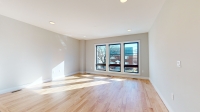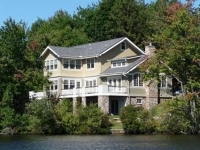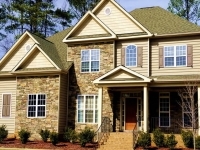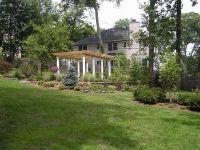No, really: how do I heat my house?
Oct 20, 2014 at 4:26am Edited
One of many reasons we had to sell our 1930s home. A battle we never could figure out and $700 heating bills every winter month. Good luck!
if you can afford it, consider re-tiling your water rooms with radient heat underneath?
That or it seems air flow may be an issue, are you keeping doors open or closed? Ie we keep bathroom doors slightly closed to keep heat in the room vs flowing to the hall where we do not have radiators
That or it seems air flow may be an issue, are you keeping doors open or closed? Ie we keep bathroom doors slightly closed to keep heat in the room vs flowing to the hall where we do not have radiators
It is a long shot, but we found that the first floor of our house was "over supplied" with radiators. No plumber told us this, we just figured it out when we shut off a couple and then took one out in a renovation. The downstairs was heating up to temperature, and turning off the thermostat, before the upstairs had time to heat. The downstairs radiators are also by default closer to the boiler (I hope you don't have a furnace, but that would explain the problem ;-)) and heat sooner.
Try shutting off one or two downstairs radiators, especially if you have ones that are in the core of the home, away from outer walls. Also try shutting off the one closest to the thermostat.
Apologies if you have already tried this.
Also second the rec to keep water rooms (like that euphemism) doors closed to trap the heat.
Try shutting off one or two downstairs radiators, especially if you have ones that are in the core of the home, away from outer walls. Also try shutting off the one closest to the thermostat.
Apologies if you have already tried this.
Also second the rec to keep water rooms (like that euphemism) doors closed to trap the heat.
When I was growing up, we lived in a old house that did not have heat to the bathrooms or the kitchen. Not because it couldn't, but because my mother thought it was too much heat, so they turned off the registers. I learned that bathrooms and kitchens were cold places... Now I have radiators in my bathroom and my kitchen (two!) and I love it. My bedroom is still cool, but I like it that way. My house is old... Circa 1910.
I don't have a solution, just commiserating.
One thing we did do when we had a problem was turn the heat as high as it would go for a couple of hours... I don't know why that worked, and I can't ask, but it did.
I don't have a solution, just commiserating.
One thing we did do when we had a problem was turn the heat as high as it would go for a couple of hours... I don't know why that worked, and I can't ask, but it did.
Space heaters in the cold rooms? I know it's not the ultimate answer, but it works for us. We have a few with thermostats, so no energy (or heat) is lost. And the cost is pretty low.
Our previous owners took out the radiator in our dining room - where the thermostat is. I'm sure it helped a little - but we do have issues with heat getting to the second/third floors.
We also tried balancing the system.
Overall, everything will heat up if the furnace is on long enough. I think if the furnace fired up every time the temperature goes down 2 degrees to gain 2 degrees back - it would work better.
One plumber did tell us that our furnace is too small for the house. So I'm a little convinced that this may be a possibility and the furnace doesn't have the power to push the heat up as fast.
We also tried balancing the system.
Overall, everything will heat up if the furnace is on long enough. I think if the furnace fired up every time the temperature goes down 2 degrees to gain 2 degrees back - it would work better.
One plumber did tell us that our furnace is too small for the house. So I'm a little convinced that this may be a possibility and the furnace doesn't have the power to push the heat up as fast.
Oct 20, 2014 at 5:20am Edited
When we replaced our 45 year old furnace and the thermostat (which you've done) it got very toasty on the 2nd and 3rd floors.
Our house was built in 1915.
Our house was built in 1915.
Our furnace/boiler (don't know differenxe) is the first out 1910 house had. We are switching to gas in a few weeks after five years of freezing despite outrageous Petro bills.
roofin said:
Space heaters in the cold rooms? I know it's not the ultimate answer, but it works for us. We have a few with thermostats, so no energy (or heat) is lost. And the cost is pretty low.
This is what we do. It's not elegant, but it's cheaper than rerouting steam pipes.

For a radiator that never heats, a plumber once drove shims under the front legs as well as the back. Something about the pitch of the steam pipe (we have one pipe system).
My furnace heats the house well, but the noise of the pipes banging drives me nuts (yes, I've had the radiators bled). I think that since I'm home now, it's something I will have to address with my plumber. Ugh.
max_weisenfeld said:
It is a long shot, but we found that the first floor of our house was "over supplied" with radiators. No plumber told us this, we just figured it out when we shut off a couple and then took one out in a renovation. The downstairs was heating up to temperature, and turning off the thermostat, before the upstairs had time to heat. The downstairs radiators are also by default closer to the boiler (I hope you don't have a furnace, but that would explain the problem ;-)) and heat sooner.
Try shutting off one or two downstairs radiators, especially if you have ones that are in the core of the home, away from outer walls. Also try shutting off the one closest to the thermostat.
Apologies if you have already tried this.
Also second the rec to keep water rooms (like that euphemism) doors closed to trap the heat.
Agree with this and it is what helped for us. We actually took out two radiators and then installed one in another room.
new windows and a larger capacity boiler.
eta: consider also removing radiators from bath and replacing heat source with radiant flooring or an exhaust fan/heat combo. the fewer radiator sources will better redistribute heat to other rooms.
eta: consider also removing radiators from bath and replacing heat source with radiant flooring or an exhaust fan/heat combo. the fewer radiator sources will better redistribute heat to other rooms.
Location of the thermostat is a key factor. Ours is in a relatively cool part of the house. Check to make sure that you have the right kind of thermostat for your heating system. Conditions improved considerably when we replaced the thermostat that came with the house with the kind recommended by our plumber. Your fuel supply company may offer a home energy audit, ours did. The person who performed the energy audit gave us all sorts of great tips for optimum insulation. Who knew that outlet covers can help make a space warmer? Have you checked your windows to determine if they are leaking around the frame? Do you have storm windows and doors? Are you using insulated window treatments? Do you have carpeting on your floors? All of this can help to make a home feel warmer.
orzabelle said:
Our furnace/boiler (don't know differenxe) is the first out 1910 house had. We are switching to gas in a few weeks after five years of freezing despite outrageous Petro bills.
Furnace - hot air, Boiler - hot steam/water (is my best guess)
I agree with Max. We turned off the biggest radiator we have which is in the living room near the thermostat. That helped a lot. The smaller radiators in the dining room, room some call Maplewood others don't, and the small hall near the laundry/bathroom take longer to warm the first floor to the temperature we want on the thermostat giving the upstairs time to warm up nicely.
We also were gifted a NEST thermostat from a very kind MOLer who it wasn't working out for and for us it works great (but took a while to get the schedule right.) It has a setting for radiator/steam and learns how long it takes to heat up your home and also goes on the internet to find out the current temperature as that might effect the heat up time. So if you want it to be 68 at 7AM Monday to Friday it figures out it will take an hour to heat up to that temp and turns on the boiler at 6AM. Very cool.
So if you have a radiator in the room with the thermostat start by closing the shut off valve and see if that helps at all.
You may have a problem with the pitch of the supply and return pipes. If the pipes are pitched incorrectly, due to improper installation or sagging. you may have a plug of water trapped in the pipe, that prevents steam from reaching the radiator. A, good, heating contractor should be able to diagnose this. Good luck
Nest's algorithms can get pretty sophisticated. The first cold night I set the trigger point for 65- it fired up the boiler as the temperature fell through 67 as it knew it would take 2+ hours to come to temperature and "caught" the falling temp at 65, rather than waiting for 65 to trigger and dipping below as it came up to speed. We've had the Nests in for a couple of years now and they know the house well.
Doesn't sound like it would solve your expressed problem as it's highly localized, which Nest struggles with as well- there's a zillion user requests on their website for wireless remote temp gauges that could help to even out whole home heat.
Doesn't sound like it would solve your expressed problem as it's highly localized, which Nest struggles with as well- there's a zillion user requests on their website for wireless remote temp gauges that could help to even out whole home heat.
6dave6 said:
You may have a problem with the pitch of the supply and return pipes. If the pipes are pitched incorrectly, due to improper installation or sagging. you may have a plug of water trapped in the pipe, that prevents steam from reaching the radiator. A, good, heating contractor should be able to diagnose this. Good luck
If you have a level you can compare the pitch of those that work against those that don't...this idea sounds like a very good (and cheep) place to start on your own.
In past threads, a book was mentioned - The Art (or lost art) of Steam Heating - that was supposed to be the bible of how to heat with steam.
One other piece of advice - we were told to keep the off/on temp within 4 degrees. Somehow that makes steam work better. I was told that steam was most inefficient during the heating up phase - but really efficient during the last - currently heating phase - and that you needed to keep the temp in that 4 degree window.
Right now we have the low at 64 and the high at 68 during the day. At night we keep it at 55 and it comes on at 4am - so that it's warmish by 5am when spouse gets up and toasty by 6:30am when I get up. It goes off at 9am - with it it coming back on if it dips to 64 in the house - and then fires back up at 4pm to 10pm.
Thermostat is on an inside wall in the middle of the house - which is a problem since it's warmer there.
One other piece of advice - we were told to keep the off/on temp within 4 degrees. Somehow that makes steam work better. I was told that steam was most inefficient during the heating up phase - but really efficient during the last - currently heating phase - and that you needed to keep the temp in that 4 degree window.
Right now we have the low at 64 and the high at 68 during the day. At night we keep it at 55 and it comes on at 4am - so that it's warmish by 5am when spouse gets up and toasty by 6:30am when I get up. It goes off at 9am - with it it coming back on if it dips to 64 in the house - and then fires back up at 4pm to 10pm.
Thermostat is on an inside wall in the middle of the house - which is a problem since it's warmer there.
In our old house, a 2 story 2 family house, the thermostat was at the farthest point on the second floor. When the former downstairs tenants said it was too cold on the first floor, they moved it down to the first floor...and we were cold on the second floor. ( we didn't own it at the time). Once it went back on the second floor, all was fine.
They had the thermostat on the wall that was right over the boiler so once it reach the temp there, it shut off.
They had the thermostat on the wall that was right over the boiler so once it reach the temp there, it shut off.
JamesKPolk,
Steam heat is surprisingly simple and yet too often misunderstood.
The pitch of the radiators is a minor point in its effective function.
I do about 50 full-home/building steam heat system evaluations every year, mostly in townhouses and medium-sized multifamily buildings (up to about 60 units) but certainly everything in between.
There are very few things that prevent a radiator from getting hot in a typical 1-pipe steam heating system (what you very likely have) and the bottom line is this:
What keeps a radiator from getting hot:
1. Insufficient venting - the moving steam isn't able to push air out of its way fast enough to heat the radiator during the "run" cycle before the boiler shuts down.
2. Steam meeting standing water - the pitch of radiators, branch piping and main piping being wrong will trap water. When steam meets the water the steam condenses very quickly and with a great BANG stops being steam. Radiators on that line are then out of luck.
3. Boiler size - boiler is too small for the system it serves - or too big. Boiler output and the system's ability to convey and condense steam and allow for the return of condensate to be reheated are a critical match.
4. Mechanical closure - a valve is off or broken in the off position
5. Pressure settings - steam travels faster under lower pressure because it is larger in size and occupies more space within the pipes
6. Pipe size - do the main or branch pipes have the capacity to supply steam to a given portion of a system
The pitch necessary for your heating system's main piping is roughly one inch in twenty feet. In other words, 1/20th of an inch per foot is all the difference in height you need when pitching your mains. Double that value for your radiators: 1" in 10' or 1/10th of an inch per foot.
It has to do with where parallel flow and counterflow exist in the system...don't worry about it.
That all being what it is, there is a solution to every cold radiator on God's green earth.
Balancing often takes a couple of attempts, but it happens.
Here's a pic of a well-vented steam radiator in the beginning of its cycle scanned with my thermal imaging camera.
Let me know if you need anything.
Operators are standing by!

Steam heat is surprisingly simple and yet too often misunderstood.
The pitch of the radiators is a minor point in its effective function.
I do about 50 full-home/building steam heat system evaluations every year, mostly in townhouses and medium-sized multifamily buildings (up to about 60 units) but certainly everything in between.
There are very few things that prevent a radiator from getting hot in a typical 1-pipe steam heating system (what you very likely have) and the bottom line is this:
What keeps a radiator from getting hot:
1. Insufficient venting - the moving steam isn't able to push air out of its way fast enough to heat the radiator during the "run" cycle before the boiler shuts down.
2. Steam meeting standing water - the pitch of radiators, branch piping and main piping being wrong will trap water. When steam meets the water the steam condenses very quickly and with a great BANG stops being steam. Radiators on that line are then out of luck.
3. Boiler size - boiler is too small for the system it serves - or too big. Boiler output and the system's ability to convey and condense steam and allow for the return of condensate to be reheated are a critical match.
4. Mechanical closure - a valve is off or broken in the off position
5. Pressure settings - steam travels faster under lower pressure because it is larger in size and occupies more space within the pipes
6. Pipe size - do the main or branch pipes have the capacity to supply steam to a given portion of a system
The pitch necessary for your heating system's main piping is roughly one inch in twenty feet. In other words, 1/20th of an inch per foot is all the difference in height you need when pitching your mains. Double that value for your radiators: 1" in 10' or 1/10th of an inch per foot.
It has to do with where parallel flow and counterflow exist in the system...don't worry about it.
That all being what it is, there is a solution to every cold radiator on God's green earth.
Balancing often takes a couple of attempts, but it happens.
Here's a pic of a well-vented steam radiator in the beginning of its cycle scanned with my thermal imaging camera.
Let me know if you need anything.
Operators are standing by!

Oct 21, 2014 at 4:22am Edited
I always thought it was important to insulate the main steam pipes too? So the steem stays steem.If the house was a flip and the old asbestos insulation was removed this might cause a problem. I could be wrong?
Edited to add nice description by master plumber.
Edited to add nice description by master plumber.
Oct 21, 2014 at 5:22am Edited
Master Plvmber used that camera in my home a year ago after me wasting my time looking for my own solutions over a decade of hardly any heat and ridiculous gas bills.
He then fixed every issue and even told me the ones I shouldn't bother fixing.
Heat everywhere now. Much lower bills. There are plumbers and then there are master plumbers who know the math and science and use them to fix issues.
In other words, call Master Plvmber.
He then fixed every issue and even told me the ones I shouldn't bother fixing.
Heat everywhere now. Much lower bills. There are plumbers and then there are master plumbers who know the math and science and use them to fix issues.
In other words, call Master Plvmber.
Regarding moving the thermostat to another location... I don't get how that's worth the effort.
Lets say the thermostat is located downstairs. Upstairs is generally 10 degrees cooler than downstairs, and you'd want the temp to be 68 degrees upstairs. Well, that's when it's 78 degrees downstairs. So wouldn't setting the thermostat to 78 downstairs be the same as moving it upstairs and setting it to 68?
(This assumes you're not doing anything to balance out the temperature differential of the house/system and are only dealing with the thermostat location.)
Lets say the thermostat is located downstairs. Upstairs is generally 10 degrees cooler than downstairs, and you'd want the temp to be 68 degrees upstairs. Well, that's when it's 78 degrees downstairs. So wouldn't setting the thermostat to 78 downstairs be the same as moving it upstairs and setting it to 68?
(This assumes you're not doing anything to balance out the temperature differential of the house/system and are only dealing with the thermostat location.)
Isn't it the other way around? Warm air rises? Our first floor is way cooler than our second and third
My thermostat is in the dining room. I put a small vent on that radiator and we have no problems.
In order to add a comment – you must Join this community – Click here to do so.
Rentals
Sponsored Business
Promote your business here - Businesses get highlighted throughout the site and you can add a deal.






























We've:
* insulated every single wall using ACORN. Less drafty.
* gotten our boiler serviced every year and properly maintain/operate it during the winter
* replaced all the valves on every single radiator
* had the steam system "properly balanced." then read a book on balancing and watched 827452 Youtube videos on balancing.
* replaced one radiator that seemed to never heat (by a rec'd plumber). Did nothing.
* had a different plumber service the new radiator: "oh I see the problem here, the pitch is all wrong." Still nothing.
* had entire system serviced: "oh i see the problem here, your returns are old and need to be replaced."
* replaced the old thermostat and put in a new thermostat, painstakingly setting the schedule for optimization.
In Man vs. heating system, man is losing. We've used highly recommended plumbers so they're not the problem. But what seems to be the problem is actually diagnosing our issue:
The rooms where we need it most (bathrooms, living room, bedrooms we use) get barely any heat. "The radiators should be hot to the touch," I've been told. They are when the system is cranked to 75. Other than that, our rooms are cold. Especially bathrooms, despite being insulated.
I'm convinced the radiators have secret motion detectors, shutting off once they know we're in the room or awake, as only the empty rooms seem to get extreme amounts of heat.
Is the next lesson in home ownership basically you just keep spending money on heating until it eventually works? Hesitant to contact more plumbers as each one is more than happy to attempt to help, fix something that seems to be the problem, and a week later, we're back to having not much heat.